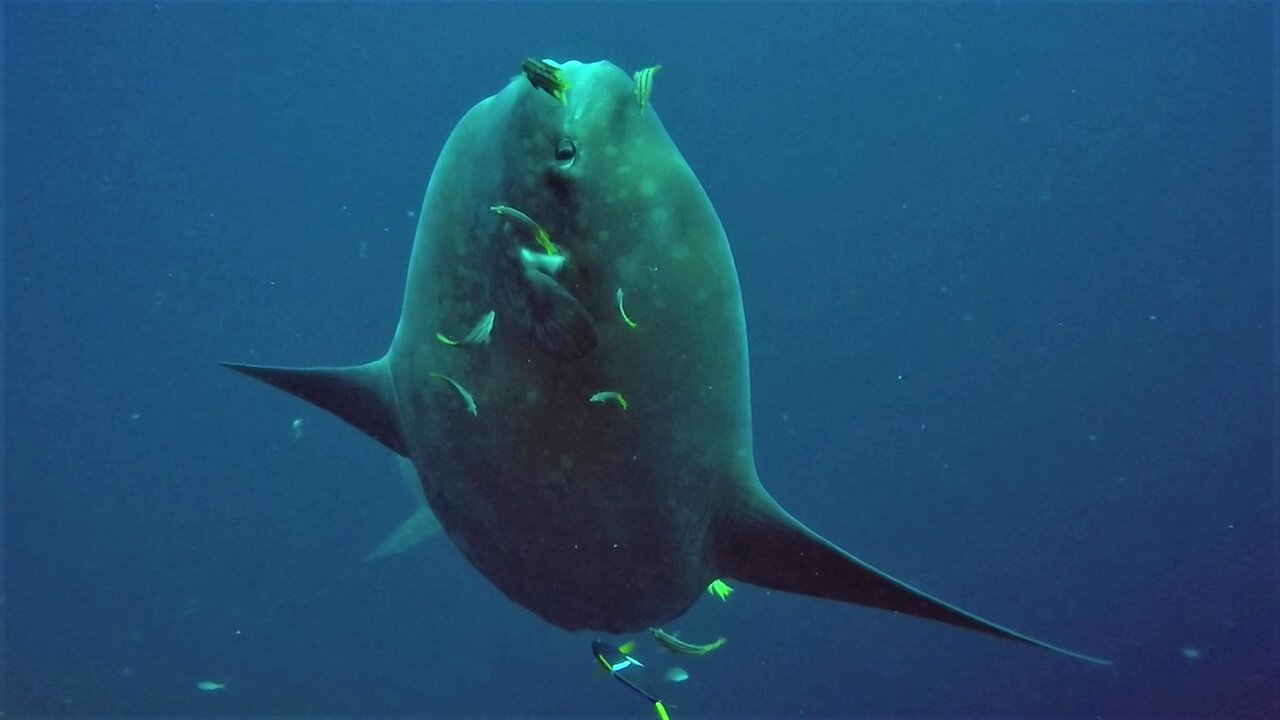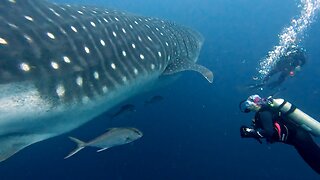Premium Only Content

Researchers sneak up on bizarre & reclusive giant Mola Mola fish
Researchers gathering underwater footage and data in the Galapagos Islands found what appears to be a Mola Mola cleaning station. These bizarre and mysterious fish grow to an incredible weight of nearly 2,270kg (5,000lbs). They are the largest of the bony fish anywhere on the planet. Often described as the animals that evolution forgot, or the fish that nature forgot, they look like a clumsy, prehistoric beast that consists of only a head and fins.
Descended from pufferfish, they have a tail that has evolved into a smaller, less obvious structure. They swim using their enlarged pectoral and ventral fins, in an unusual flapping motion. As expected, they are not fast swimmers. Although they can reach surprising speeds for very short distances, they generally swim at about 3.5km/h (2mph). When alarmed or threatened, the Moila Mola will often dive and accelerate, trying to reach depths at which their pursuers are not able to follow. They have little other ability to defend themselves.
Mola Mola are frequently referred to as ocean sunfish, due to their flattened shape. But common sunfish are unrelated to the Mola Mola and the similarity is in name and shape only.
These ocean giants swim with their mouth open at all times. They are actually incapable of closing their mouths. Originally thought to feed only on jellyfish, it is now understood that Mola Mola feed on small fish, fish larvae, squid, and crustaceans. Jellyfish comprise only 15% of their diet.
Mola Mola lay more eggs than any other vertebrate. They are capable of producing up to 300 million eggs at one time. They start out as larvae and tiny "fry" and then grow quickly, reaching a weight that is approximately 60 million times their birth weight. They will do this in a span of up to ten years. This believed to be one of the fastest growth rates of any known vertebrate animals. Their extreme growth rate and the implications that this could have for science and research are currently being studied.
These researchers have made their way along a wall where Mola Mola have been sighted previously. Carefully remaining partially concealed by the rocks, they peek out at this giant fish and record it as it suspends itself in a vertical position. This is an intentional signal to the wrasses in the area that the Mola Mola wants them to clean it, removing small parasites and dead skin. This helps the Mola Mola remain healthy and the wrasses receive a meal in return.
It's an example of a mutually beneficial, or symbiotic relationship. The researchers are recording this behaviour in what is a relatively rare opportunity to get so close to such an easily spooked animal. Tracking devices are also being installed on the fish to get a better idea of what their migration habits are. It is hoped that, as we learn more about these ocean giants, we will also gain a better understanding of how to conserve them.
-
 0:47
0:47
WildCreatures
21 days ago $0.96 earnedScuba diver has mind-blowingly close encounter with giant whale shark
2.46K6 -
 1:41:22
1:41:22
The Officer Tatum
2 hours agoLIVE: Trump NOMINATES Karoline Leavitt, Whoopi "SMOLLETT" EXPOSED, & MORE | Officer Tatum Show EP 8
14.5K17 -
 30:25
30:25
Glenn Greenwald
4 hours agoGlenn Takes Your Questions Post-Election On The Trump Admin & More
80.2K34 -
 1:26:23
1:26:23
vivafrei
7 hours agoChinese and Indian INFILTRATION in Canadian Government? Live with David Krayden! Viva Frei Live
99.1K42 -
 52:17
52:17
Candace Show Podcast
7 hours agoFight Night! Me VS Marc Lamont Hill On Transgenderism | Candace Ep 104
120K246 -
 1:12
1:12
Mike Tyson
8 hours ago $23.91 earnedIt's a war.
99.5K35 -
 1:04:11
1:04:11
In The Litter Box w/ Jewels & Catturd
1 day agoProsecute/Fauci | In the Litter Box w/ Jewels & Catturd – Ep. 692 – 11/15/2024
115K48 -
 5:17
5:17
BFFs: Dave Portnoy, Josh Richards & Bri Chickenfry
9 days agoSmallest Man
261K24 -
 1:45:03
1:45:03
The Quartering
9 hours agoRFK Big Pharma Meltdown, Alex Jones WIN & Shadow Government To Oppose Trump!
143K46 -
 1:53:23
1:53:23
Tucker Carlson
9 hours agoFasting, Prayer, Meditation, & the Global Persecution of Christians (With Hallow CEO Alex Jones)
191K84